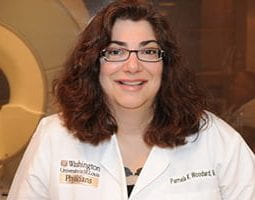FDA Clears Noninvasive CardioInsight Mapping Solution from Medtronic (Links to an external site)
The CardioInsight ECGI system was cleared by the FDA. After 30 years of development and validation in CBAC Director Yoram Rudy’s laboratory, he hopes to see ECGI in clinical use in hospitals, helping to treat cardiac patients.
Van Hare Named President-Elect of the Heart Rhythm Society (Links to an external site)
CBAC member George F. Van Hare III, MD, director of the Division of Pediatric Cardiology at Washington University School of Medicine in St. Louis, has been named president-elect of the Heart Rhythm Society, a global research and education group focused on cardiac rhythm disorders.
Researchers create first 3-D mathematical model of uterine contractions (Links to an external site)
CBAC member Arye Nehorai, the Eugene and Martha Lohman Professor of Electrical Engineering and chair of the Department of Electrical & Systems Engineering in the School of Engineering & Applied Science, and his team have developed the first 3-D multiscale mathematical model of the electrophysiology of a woman’s contractions as they begin from a single cell to the myometrium, or uterine tissue, into the uterus
How a Frankenstein Prototype Ended Up Being Worth $93M (Links to an external site)
While working a Case Western Reserve University, CBAC Director Yoram Rudy, PhD had the idea for a game-changing cardiac monitoring device–a vest filled with more than 200 sensors that could detect the heart’s electrical activity. While standard 12-lead EKGs had become the gold standard for detecting many heart problems, EKGs still can miss cardiac problems because they only probe electrical potential at a limited number of points on the body.
New insights in mechanisms of human cardiac arrhythmias (Links to an external site)
Medtronic acquired CardioInsight Technologies, developer of a clinical noninvasive imaging system, called ECGI, for noninvasive mapping of the electrical activity of the heart and cardiac arrhythmias. The ECGI concept and methodology were developed in Professor Yoram Rudy’s laboratory with support from the NIH – National Heart, Lung and Blood Institute.
NIH grant to support study of heart’s inner mechanisms (Links to an external site)
Findings could lead to better treatment for cardiac arrhythmia and long QT syndrome.CBAC member Jianmin Cui, PhD, has received a nearly $1.7 million grant from the National Institutes of Health (NIH) to study the molecular bases for the function of potassium channels vital for the heart, brain, inner ear and other tissues.
Nanoparticle that lights up artery-clogging plaque to be evaluated in clinical trial (Links to an external site)
CBAC member Pamela Woodard, MD, led a team that designed a new imaging agent that may light up dangerous plaque in arteries.
New technology focuses diffuse light inside living tissue (Links to an external site)
CBAC alumnus Lihong Wang, the Gene K. Beare Professor of Biomedical Engineering, continues to build on his groundbreaking technology that allows light deep inside living tissue during imaging and therapy.
Research opens opportunities to develop targeted drug therapy for cardiac arrhythmia (Links to an external site)
CBAC members Jianmin Cui, PhD, professor of biomedical engineering, and Mark Zaydman, fifth-year MD/PhD student, and a team of biomedical engineers has discovered that for one important channel in the heart, called KCNQ1, the membrane voltage not only causes the channel to open, but also determines the properties of the electrical signals, acting as both conductor and composer rather than only conductor as previously believed.
Wickline receives chancellor’s innovation award (Links to an external site)
CBAC alumnus Samuel A. Wickline, MD, received the Chancellor’s Award for Innovation and Entrepreneurship at Washington University in St. Louis. Wickline, the James R. Hornsby Family Professor of Biomedical Sciences, was presented with the honor at the Faculty Achievement Awards ceremony









